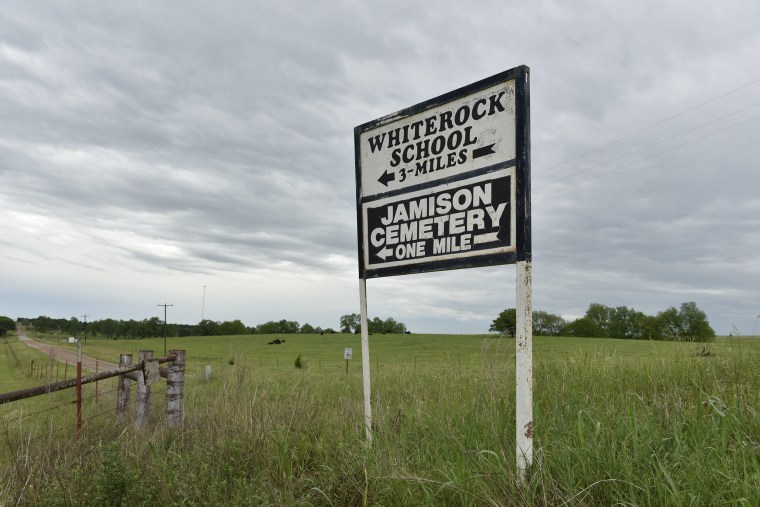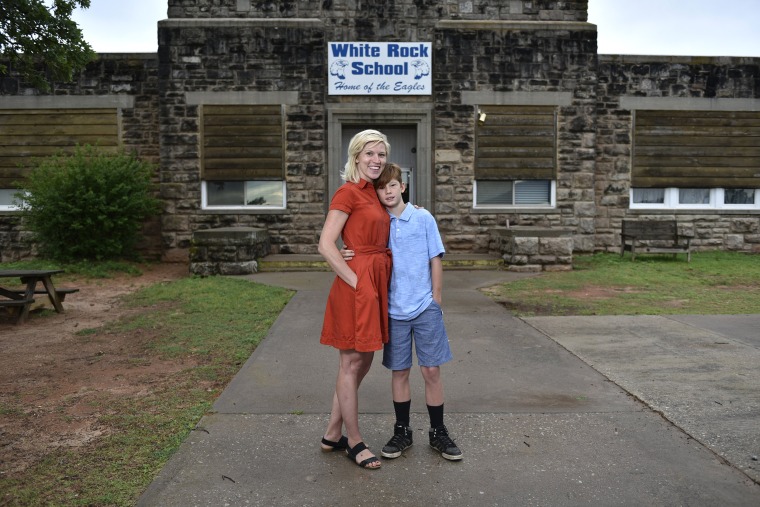McLOUD, Okla. — In many ways Oliver Prince is your typical, happy fifth-grader. He enjoys recess, gym class and time at school on the computer.
But in one key way, he, along with the other 92 students at White Rock School in this tiny, bucolic town 50 miles east of Oklahoma City, are very different: They go to school only four days a week.
The single-school district is one of the 97 of Oklahoma's 513 districts that have made the switch to the four-day week in recent years, citing struggles to cut their budgets and recruit high-quality teachers amid a nationwide teacher shortage and pay crisis that has had a particularly devastating effect on schools in the Sooner State.
"There are lots of challenges and problems that people haven’t tried to fix," Bob Gragg, the superintendent, told NBC News. “But just because we've been doing it one way for a long time doesn't mean we necessarily need to keep doing it that way.”
City school districts are taking notice. The four day-week is now beating a path to urban districts, which are facing their own crippling budget shortfalls and teacher retention challenges and are ready to try new solutions to solve growing problems.

This coming fall, Adams County School District 27J, in the northeast suburbs of Denver, has decided to shave a day off its schedule, making it the nation's first large urban school district — nearly 18,000 students are enrolled across its schools — to embark on the four-day experiment.
About 550 public school districts in 24 states across the Great Plains and western states — half are in Colorado, Oklahoma, Montana and Oregon — have a four-day week, according to the National Conference for State Legislatures. And the trend is growing: In Oklahoma, there were twice as many schools on the four-day schedule this academic year than there were last year.
The shift to four-day weeks has resulted in what parents, teachers, administrators and scholars say are better student performance and attendance, increased morale among students and teachers and an ability to recruit and keep high-quality teachers — because regular three-day weekends are a big attraction.
But now that urban districts are trying to get in on the action, critics and education experts are cautioning that larger metropolitan areas could see a raft of consequences — such as challenges arising from needing to find child care for young kids on that day when they aren't in school and the temptation for trouble for older kids with an extra weekend day — that could further throw already beleaguered public schools out of whack.
Not enough teachers
The biggest reason schools have made the switch to the short week is that the change helps with luring teachers.
Teacher demand exceeded supply for grades K-12 in the country's public schools by more than 100,000 for the first time ever this year — a dearth largely caused by endemic poor pay and the inability of districts to retain teachers due to burnout and low job satisfaction, according to the Learning Policy Institute, a Washington-based education policy think tank. The problem has been especially severe in Oklahoma.
Along the way, schools that have tried it out found that student attendance went up, along with teacher and student morale. Studies have even demonstrated that performance has increased, too.
A 2015 study conducted by two economics professors showed statistically significant gains in the standardized test scores of fourth and fifth-grade students who'd been on the four-day week in rural Colorado districts.
D. Mark Anderson, a professor of economics at Montana State University and a co-author of the study, said his team wasn't able to determine the specific factors behind increased performance, but said there was "strong anecdotal evidence" that it was a product of better attendance and more time for homework for students and class prep for teachers.
In addition, Anderson and other experts said families in rural communities that have already adopted the four-day week almost entirely have one parent, or a grandparent, at home, making child care a nonissue.
And, given that most states' public educations are governed by hours in the classroom, not days, students don't lose any time in school. In Oklahoma and Colorado, for example, students must be in the classroom for 1,080 hours in a school year.

Still, other experts point out that not enough is known about the four-day week to justify its expansion.
"We don't know what the effect is on students yet, we don't have enough information and this a pretty substantial thing to introduce to children without knowing its effects," said Georgia Heyward, a research analyst at the Center for Reinventing Public Education, an education policy analysis center at the University of Washington-Bothell.
As the trend trickles into urban areas, other experts are even more concerned about the broader effects it could have on the well-being of teachers.
"We can compensate these teachers all they want in more free time, but their pay is still not going up," said Linda Darling-Hammond, the president of the Learning Policy Institute and a professor emeritus of education at Stanford's Graduate School of Education.
Darling-Hammond pointed to the fact that teachers in Oklahoma and Colorado had to go on strike this year, and even that "only secured them very, very modest pay raises for the first time in decades."
"It's conceivable it might make a small difference in their quality of life, but if salaries aren't changing, the same issues that teachers have, as far as not being able to afford a reasonable lifestyle, will still be there," she said.
Why the short week works
Those potential drawbacks, however, haven't popped up at most of the Oklahoma districts on the four-day week, including White Rock School, the two-building K-8 school that adopted the short week two years ago.
In fact, administrators, teachers, students and parents are all really happy with the switch.
"We did it to save money and to make our teachers happier, and keep them happy," explained Gragg, the superintendent. "We've seen both of those things, and more."
The school cut its calendar to Monday to Thursday and expanded the day one hour to 8 a.m. to 3:30 p.m. from 8:30 a.m. to 3 p.m.
Gragg said the cost savings ended up being minimal (less than one percent of the school's annual budget), but that he's seen absenteeism drop and student performance increase. Students and teachers have "never been happier," he added.

On Fridays, the school offers optional educational field trips to museums and libraries, "which add to the kids’ education" — especially those below the poverty line, many of whom "wouldn't get these experiences if we didn't do this on Friday,” he explained.
Jeanette Prince, whose son Oliver is a fifth-grader at White Rock, said the four-day week "helps foster a love of learning, because things aren't as rushed."
Her fellow White Rock parents agree. Before locking back into the four-day schedule for the 2018-19 school year, the district sent out a parent survey to gauge its popularity: Eighty-three percent said they wanted to keep it.
Larger rural schools say they're thriving on the four-day week, too.
At a recent end-of-year "Arts Night," at Bridge Creek Middle and High Schools, in Blanchard Okla., about 30 miles southwest of Oklahoma City, students, parents and teachers sung their district's praises for making the switch in 2016.
Tasha Chavedo, 17-year-old senior at the Bridge Creek High School, which is in session Monday to Thursday, said her grades have improved.
"I can use the weekend more to process what I learned," said Chavedo, who spends her Fridays working at Papa John's and uses her paycheck to pay for her car insurance.
Denver gets ready
The four-day school week is nothing new in Colorado, where 98 (or 55 percent) of the state's 178 public school districts have at least one school on the altered schedule.
But no major urban areas had adopted the measure — until now.
Adams County 27J, a K-12 district in Denver's northeastern suburbs with more than 18,000 students enrolled, will institute a Tuesday-to-Friday schedule in its schools this fall.
The primary reason?
"Retaining, developing and attracting quality teachers for our kids," said 27J superintendent Dr. Chris Fiedler. "We have been bleeding teachers."
Fiedler admitted the tactic was "a drastic measure," but explained that his district only began considering it after facing a budget shortfall and a steady stream of departures of his best teachers.
"We have the lowest beginning and average salary in the Denver metro area," he said.
Under the new schedule, which begins in August, the elementary school days will be extended 40 minutes and the high school schedule will implement a longer, eight-hour day, from 8:30 a.m. to 4:30 p.m.
Making the shift will free up about $1 million in transportation and utility costs, about one percent of the district's yearly budget.
The bigger perk, however, is the draw of keeping the best teachers and attracting even better ones.
So far, Fielder says it's worked. After years of getting just a few applicants for several open positions, he said his district is now getting hundreds.
"We got 181 applicants for an elementary school job, we got more than 100 for multiple others. These jobs are looking more attractive to people, as we'd intended," he said.
Experts, however, caution that the effectiveness of the four-day school week has only been measured in rural settings, where the schedule's benefits can seem tailor-made for schools that face a set of challenges unique to tiny, small-town schools.
"Trying to use these results as they are, and applying them to urban schools is really stretching it," said Mary Beth Walker, a professor of economics at Georgia State University, who co-authored the study that showed four-day school week had a positive impact on student performance.
Despite those warnings, as well as mixed reactions by parents to the district's March 19 announcement on Facebook, Fiedler isn't concerned.
"I don’t see us going back unless something enormous changes," he said. "Do I think it's going to be successful? I am betting on it."
CORRECTION: (May 21, 2018, 9:54 a.m., ET): A previous version of this article misstated Oliver Prince's grade level. He is in fifth grade, not first.
